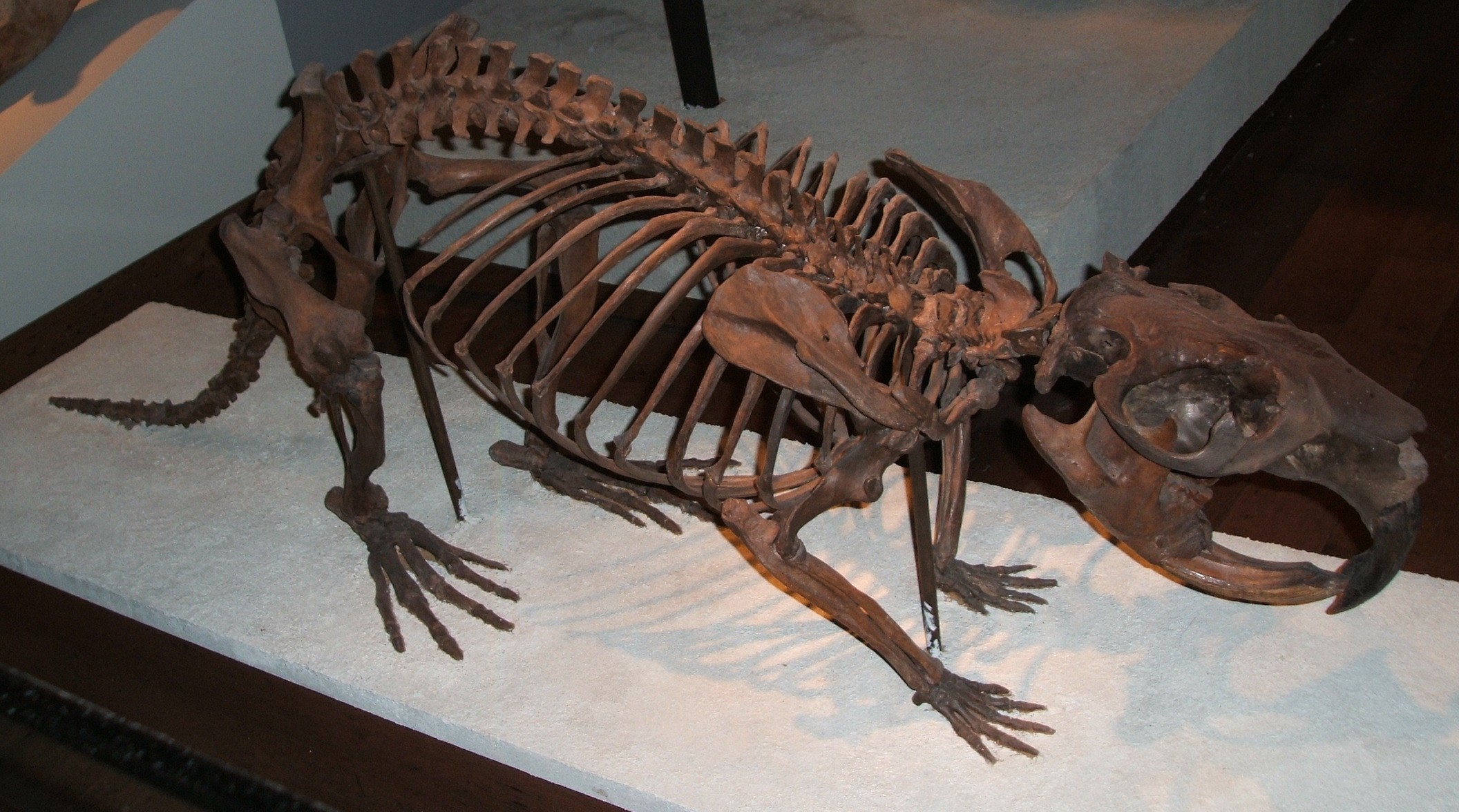
This unglamorous scientific name acknowledges that the first skeleton of the prehistoric GIANT BEAVER was discovered at the bottom of a peat bog in Ohio. The year was 1837, and remarkably we have no records of this bear-sized creature before that. The great creature started out about 3,000,000 years ago and became extinct after the last ice age about 10,000 years ago. That means that giant beavers roamed North America with early man, and yet we have no cave drawings or artifacts to tell us more.
Castoroides ranged from Florida to the Yukon, and from New York State to Nebraska, but it has not been found outside of North America. Giant beavers seem to have flourished in the region south of the Great Lakes toward the close of the last glaciation. In fact, three nearly complete specimens are known from Fairmont and Winchester, Indiana, and from Minneapolis, Minnesota.
Yukon-Beringer Interpretive Center
What we do know is that Castorides had bigger back feet and thinner vertibrae in its tail than our modern beavers. Sometimes it is shown with a muskrat-like tail in drawings, or a thinner beaver-like tail. Its big feet made it even more ungainly on land so it couldn’t disperse by walking and when the great lakes began to change it may have just been unable to adapt.
Aside from having people for neighbors, Castorides also had Castor Canadensis, whose smaller multi-function size survived the ice age and went on to great things. Ancestors of Canadensis were specialists rather than generalists. There were smaller beaver species that were strong diggers and larger beavers that were strong swimmers. There was even a beaver the size of a mouse! Castor Canadensis, by all accounts, had it all.
Today’s beavers “do it all” by digging, swimming, cutting wood with their teeth and building dams. Their ancient relatives, however, seemed to be divided up into those that were digging and burrowing specialists and those that spent more of their time swimming and munching vegetation.
Jennifer Viegas: Discovery News
For some reason, cave men didn’t draw pictures of beavers and we have no images to show us what they looked like. Apparently they didn’t even hunt beavers. Maybe there were so ubitous that no one thought to represent them….like parking meters…or maybe there were other reasons. Most historians speculate that the Algonquin myth about the fierce beaver-monster “Wishpoosh” (who refused to allow anyone to fish in his pond) is actually an echo of Castorides.
Now Wishpoosh the monster beaver lived in the beautiful Lake Cle-el-lum which was full of fish. Every day, the animal people would come to the lake, wanting to catch some fish, but Wishpoosh the giant beaver drove them away with many threats and great splashing. If they refused to leave, Wishpoosh would kill the animal people by dragging them deep into the lake so that they drowned.
(Never mind that Castorides didn’t eat fish any more than Canadensis. Beavers were apparently always misunderstood. I guess if there’s a beaver myth right inside of an actual beaver myth we shouldn’t be surprised.)
Anyway the story says that Coyote felt badly for the animal people and took on this monster beaver in battle. They fought so hard that they splashed water everywhere and made the cascades and all the surrounding lakes, but in the end the wiley Coyote was victorious, killed the monster and hauled the carcass up onto land where he cut it into pieces to become the tribes of the nation
Coyote was tired after his long fight with the monster beaver. He called to his friend Muskrat, who helped drag the body of Wishpoosh to shore. Coyote and Muskrat cut up the giant beaver and threw the pieces up over the land, thus creating the tribes of men. The Nez Perce were created from the head of the giant beaver, to make them great in council. The Cayuses were created from the massive arms of Wishpoosh, in order that they might be strong and powerful with the war club and the bow. From the beaver’s ribs, Coyote made the Yakimas and from the belly the Chinooks. To make the Klickitats, Coyote used the beaver’s legs, so that they would become famous for their skill in running. With the leftover skin and blood, he made the Snake River Indians who thrived on war and blood.
Wishpoosh aside, a possible prehistoric lodge has been found in that peat bog in ohio, but no dams were ever located. Its speculated that Castorides didn’t have the skill to build dams.Imagine that, a giant beaver that doesn’t get noticed and can’t build a dam. Completely unlike Castor Martinium.
Giant beavers seem to have preferred lakes and ponds bordered by swamps as their habitat, because their remains have been found in ancient swamp deposits so often. Perhaps a rather sudden reduction of these surroundings due to changing climate linked with the giant beaver’s apparent inability to build dams like those of Castor canadensis and its inability to disperse readily overland to new drainage systems when drought occurred may have resulted in its extinction and the survival of the smaller, more adaptable modern beaver. Likewise, the Eurasian “giant” beaver, Trogontherium, gave way to the living Eurasian beaver (Castor fiber), but earlier.
If you’re curiosity about Castorides has been at all peaked, you must come see ol’ Wishpoosh at the Beaver Festival. I promise he won’t disappoint.

1 . wishpoosh R. M., Indian Legends. Lyons and Carnahan. 1925-1938. xvi, 366 pp; illus. Vocabulary. Index, [N 970.6 L98i] m_origin, c_Beaver, r_Interior Salish.
2 . wishpoosh Peery, Wilson Kimsey, And There Was Salmon. Portland, OR: Binfords & Mort. 1949. [96] pp; illus., [N 970.6 P346a] m_river monster, c_Spilyaay, c_Wishpoosh, r_Coast Salish.






































